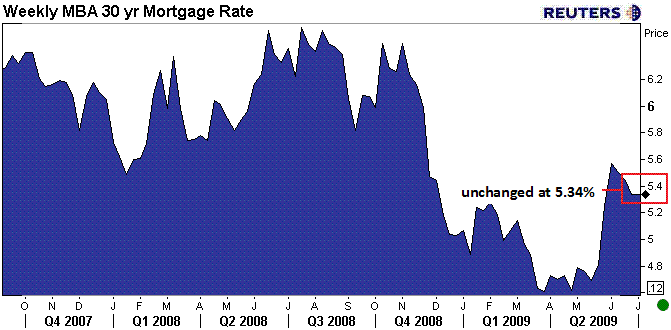As I stated in yesterday's blog, continued improvements in prices of mortgage backed securities (as price goes higher, rates go lower) will require further weakness in stock markets. If equity indices continue to move lower it would re-ignite investor's inclination towards protecting their assets, also known as risk aversion. An increased appetite for risk averse assets would be beneficial for Treasury yields, which would then allow MBS prices to move higher, which would then afford lenders the opportunity to lower mortgage rates. See how interconnected the marketplace is?
Well, that is what happened yesterday as the notion that the recession is over is quickly dissipating and the perception that a long slow recovery has begun to take hold over the marketplace. The Dow lost over 160 points and the benchmark 10 year treasury note fell to a yield of 3.45 after reaching an intraday high of 3.54. Following the decline in Treasury yields (flatter yield curve), MBS moved higher in price by about 25 basis points which allowed several lenders to reprice for the better, by day's end mortgage rates were about 0.125bps better.
Yesterday, the first of three Treasury debt auctions was held. The Treasury Department auctioned off $35billion 3 year notes. Although market participants demanded a higher than expected yield, demand was still strong. After the auction the Treasury and MBS markets were a bit volatile, but eventually composure was regained after weakness in stocks overshadowed the mixed auction results.
Today, at 1pm eastern, the US Treasury Department will auction $19billion 10 year notes. Since the average life of a mortgage is much closer to 10 years, this auction is much more relevant to "rate sheet influential" MBS compared to yesterday's 3 year auction. A successful auction should benefit MBS while a weak auction could result in MBS prices moving lower which would consequently increase consumer borrowing costs. To gauge the success at these auctions, market participants look at the bid to cover and the demand from indirect bids. The bid to cover is a ratio of how many investors bid for a single note. For example, if the bid to cover is 3.00 that means that there were three bidders for every note awarded. The higher the bid to cover the better the auction. Next, market participants look at the indirect bid which are bids from foreign investors. We are hopeful for indirect participation in the range of 65% of the issuance. Matt and AQ will cover the results of the auction once it is completed on their MBS Commentary blog.
We did receive one piece of economic data this morning, the MBA applications index. This report measures the weekly change in the number of applications at mortgage lenders. Last week's report showed a sizeable drop in both purchase and refinance activity due to a sudden rise in mortgage rates. This week's report indicated that purchase activity improved 6.7% from a recent 9 month low. Refinance activity also bounced off monthly lows, improving 15.2%. The increase in demand for mortgage applications occurred while mortgage rates were unchanged at 5.34% (in the week ending July 3, 2009). READ MORE

Early reports from fellow mortgage professionals are indicating that the par 30 year fixed rate mortgage has fallen to the 4.875% to 5.125% range for the best qualified consumers. In order to qualify you must have a FICO credit score of 740 or higher, a loan to value at 80% or less and pay all closing costs associated with loan including 1 point loan origination/discount/broker fee. As always, you can elect to pay less in costs and take a higher interest rate. That is a good option for consumers only planning on keeping home for less than 3 years. For consumers keeping their home for a longer period, they should pay the cost of 1 point to secure the lower rate. The savings from the lower interest rate would offset the upfront cost in about 3 years.
If you are currently floating, the 10 year auction has the potential to be a significant market mover. Over the past 10 days, mortgage rates have moved considerably lower, so now might the time to take profits while they are still on the table. On the other hand, there is still significant upside potential that mortgage rates will move lower if stocks keep selling off. It's a tough call, make sure you calculate the payment differences between different rates before deciding whether or not to float.




